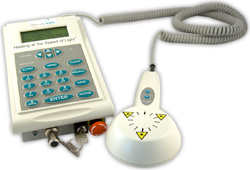Infrared Laser
The therapeutic uses of cold or low powered laser are quite significant and can be explained by the following mechanisms. The laser at a low output can be thought of as an anti-inflammatory agent. It also is known to increase and normalize circulation. There is also a strong effect on reducing pain. These effects are produced by a general bio-stimulating effect on body cells. There is evidence to show increased micro-circulation and cellular activity, which promotes healing and modifies enzyme reactions either stimulating or inhibiting them.
In general there are:
PRIMARY OR DIRECT EFFECTS:
1. Biomechanical
2. Bio-electric
3. Bio-energetic
INDIRECT EFFECTS, which are local, regional, general:
1. Stimulate microcirculation
2. Stimulate cellular activity
GENERAL THERAPEUTIC EFFECTS:
1. Reducing pain (analgesic)
2. Reducing inflammation (anti-inflammatory), reducing swelling (anti-edema), affects normalizing of circulation.
3. Bio-stimulating effects
ACUPUNCTURE LIKE EFFECTS - these effects can be used similarly to needles in certain cases.
There are many conditions that respond to laser treatment because of the above mechanics.
There are obvious applications of laser for problems in the neuromusculoskeletal system, specially with trauma to muscles, tendons, ligaments and joints. Laser is very effective with partial ligament, muscular and tendon tears because of its role in reducing pain and swelling. It will:
1. Accelerate the quality of healing;
2. Avoid malformation of scar tissue;
3. Achieve better functional recovery together with reducing pain.
In acute situations laser can prevent secondary complications such as calcific deposits in muscles.

The laser accelerates cell function to improve rebuilding of tissues and speeds up healing. It also helps to prevent the formation of imperfect scar tissue and adhesions.
In nerve injuries laser acts in the following ways:
1. Reduces muscular spasm by its ability to reduce pain.
2. Activates circulation and reduces build up of waste products of the nerves and surrounding areas.
3. Reabsorbs edema (swelling).
4. Increasing nervous and muscular sensitivity.
5. Prevents rigidity and contractures.
6. Prevents formation of adhesions (scars).
Even in bone healing is promoted. Laser accelerates the formation of callus (new bone around fracture site) and frees the muscles of anoxia (low oxygen). It also prevents loss of elasticity in the capsules and ligaments due to antifibrinic (reduction of clotting proteins) action and stimulation of arterial circulation produced by the lasers supply of energy.
The analgesic effect results in greater ease of motion due to muscular and articular (joint) functional recuperation.
There are many specific conditions in which laser is utilized. Here is a partial list:
- Rheumatoid arthritis
- Osteoarthritis
- Tennis elbow
- Ligament strains of the knee
- Bursitis of the knee, elbow, shoulder
- Sprained wrist
- Nerve irritation such as carpal tunnel syndrome
- Sciatica
- Ulnar neuropathies
Laser treatments, linked to general principles such as avoiding obesity, overloading joints, proper rest and exercise are highly successful in delaying the degenerative processes that occur in our bodies.
This is just a short introduction to the way modern technology can apply a positive role in your chiropractic treatment program.
